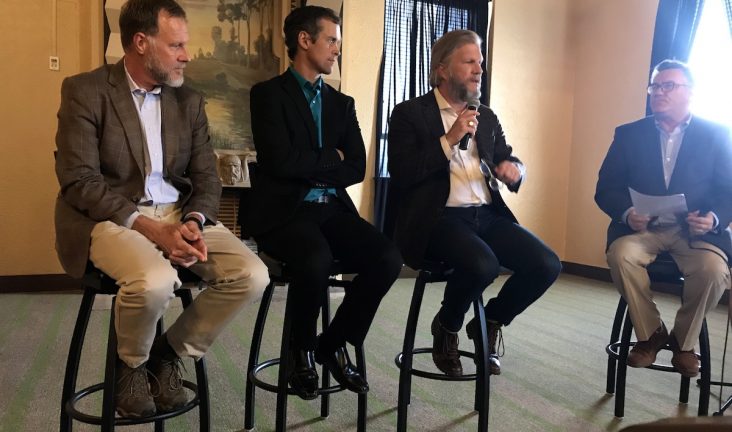Downtown Fort Smith momentum about hitting ‘doubles and singles’ instead of home runs
by October 31, 2018 3:44 pm 1,078 views

Developing downtown Fort Smith is more about hitting “doubles and singles” than home runs, with the area’s future “pretty vibrant, pretty exciting,” according to Bill Hanna, one of three panelists participating in the opening discussion of Invest Fort Smith.
64.6 Downtown partnered with the Fort Smith Regional Chamber of Commerce to host Invest Fort Smith, a one-day summit designed to build awareness of downtown economic development opportunities. Roby Brock, CEO of Talk Business & Politics, was the panel moderator for the opening and closing panel discussions.
Hanna, owner of Fort Smith-based Hanna Oil & Gas, and a downtown property owner, told the audience of 130 gathered at Temple Live! that the Propelling Downtown Forward strategic plan initiated in early 2017 is different from other plans because it was rolled out to build upon momentum rather than trying to create momentum. He added that the plan, developed by Texas-based Gateway Planning, needs to be followed and not put on a shelf.
“It’s not worth anything if we don’t use it. … We did it at a time when this momentum, this inertia, had begun,” Hanna said, adding that “the follow-through is there” and the rise in art and culture in the area is feeding construction, and vice versa.
A “pivot point” for that momentum was the April 1996 tornado that hit the downtown area hard, according to panelist Sam Sicard, president and CEO of First National Bank of Fort Smith. That ultimately led to a more than $50 million voter-approved sales tax hike that paid for investments in riverfront amenities, visual improvements along Garrison Avenue, expansion of the convention center and expansion of the city’s library system.
Steve Clark, founder of Fort Smith-based Propak Logistics and founder of 64.6 Downtown, said the “combo” of developments from 1996 until now have created the inertia that is now present. He also said the inertia is partially a result of people in the city realizing that “no cavalry is coming to save us,” and the citizens have to “fight a little harder to make things happen.”
“We’re coming to the conclusion that we can in fact effect the outcome,” Clark said. He added later in the discussion that “five years from now, I think it’s (downtown Fort Smith) really going to be an exciting place to be.”
The three panelists agreed that the U.S. Marshals Museum, set to open September 2019 on the riverfront, will be a momentum driver, with Hanna saying the museum will be a “huge catalyst” for the region.
Sicard said a key factor in future downtown success will be in bringing more jobs to the area. To do that, he said city, chamber and other leaders need to paint a picture to business decision makers of what the downtown can be and allow them to be part of the vision for growing the area. Clark said continued addition of of amenities is key to recruiting jobs because “you have to create a place where people want to be.” He also said the city has a “seed growth” role in that city officials have to determine what they want and how the city will work with the private sector to incentive the recruitment of jobs and young people to the area.
One potential city action will require addressing truck traffic in the downtown area, Hanna said. The trucks are loud, are not pedestrian friendly, and make it difficult to create a walkable urban environment. The controversial issue has been discussed over the years, with no resolution reached. A study is ongoing that might provide options.
“If we want our downtown more livable, we’re going to have to figure out what to do with trucks,” Hanna said. “We have to figure out how to quiet downtown. That’s the challenge.”
Following are some of the other areas discussed.
• Retaining youth, talent
Hanna said engaging younger demographics is key to keeping them in the Fort Smith area. He also said it is important for “younger voices” to be listened to. Sicard paraphrased a saying by downtown developer Richard Griffin, who tells young people they can move off to larger cities, and they won’t notice you when you get there, and they won’t notice when you leave. But in Fort Smith you have a bigger opportunity to make a difference.
Clark said he is not disappointed to see young people leave, as long as “we make the place a good place for them to return,” because they then return with their experiences and life lessons from larger areas.
• Future leadership
It’s important to pull younger people into the leadership mix, but young people need to realize just engaging on social media is not fully engaging, Clark said. Hanna added that a leadership “succession plan” is needed to find “people who can carry the water.” He urged business and civic leadership to keep that in mind when planning for the future.
Clark said part of that leadership is electing people who support amenity development.
“Amenities need to be a ballot issue. … Candidates need to be required to talk about amenities. If they say it’s not that important, then they don’t know how they economy works,” Clark said.
• What’s next?
Brock asked each of the panelists to provide, if possible, a teaser about what is in the works for future downtown development. Hanna said it would be nice if a roof could be installed over the amphitheater in Harry E. Kelley Park. He also said there is an effort to buy 300 acres from Kansas City Southern railroad in the downtown area near the river to build trails and other amenities.
Sicard didn’t offer specifics, but did say ideas are in the pipeline.
“We have big ideas. We’re not done with improving our downtown. We’re just getting started. The hardest part is getting started, but we’ve done that.”
